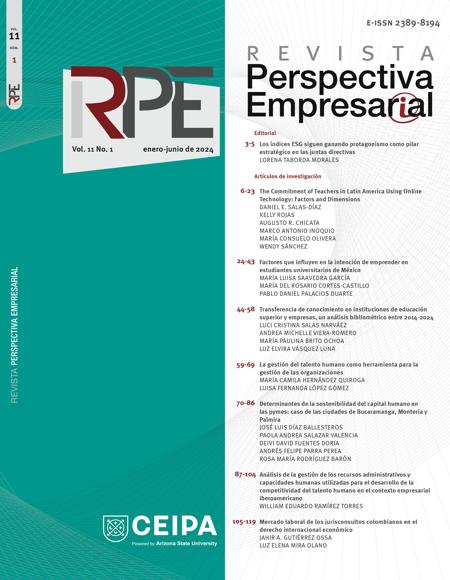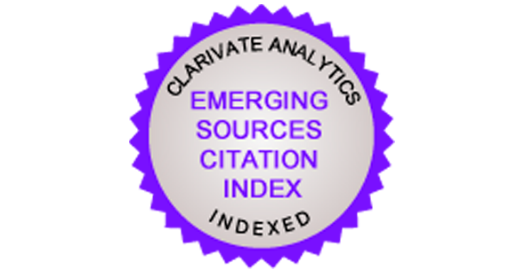Gestão de talentos humanos como ferramenta para gerenciamento organizações
##plugins.themes.bootstrap3.article.main##
ferramenta para a gestão das organizações. Metodologia. Uma meta-análise foi realizada em
base de dados Scopus, com o objetivo de identificar a relação entre satisfação
gestão de mão de obra e recursos humanos e gestão organizacional e gestão de recursos
humano, uma vez que esses critérios têm sido vinculados a questões organizacionais e
talento humano em pesquisas anteriores. Resultados. Gestão de talentos humanos
é a base para a gestão ideal dos processos administrativos porque quando
promover estratégias focadas no fortalecimento do relacionamento com os colaboradores, o clima
o desenvolvimento organizacional e de habilidades influencia positivamente o desempenho
trabalho e produtividade. Conclusão. O sucesso de uma empresa depende em grande parte da
nível de satisfação de seus colaboradores com relação ao ambiente organizacional.
Downloads
##plugins.themes.bootstrap3.article.details##
Almeida, S. et al. (2019). Retaining health carers: the role of personal and organisation job resources. Journal of Organizational Effectiveness, 6(2), 98- 113. DOI: https://doi.org/10.1108/JOEPP-06-2018-0036
https://doi.org/10.1108/JOEPP-06-2018-0036 DOI: https://doi.org/10.1108/JOEPP-06-2018-0036
Alzate, I. et al. (2022). Meta-analysis of organizational and supply chain dynamic capabilities: A theoretical-conceptual relationship. Problems and Perspectives in Management, 20(3), 335-349. DOI: https://doi.org/10.21511/ppm.20(3).2022.27
https://doi.org/10.21511/ppm.20(3).2022.27 DOI: https://doi.org/10.21511/ppm.20(3).2022.27
Aydin, B. and Ceylan, A. (2008). The employee satisfaction in metalworking manufacturing: How do organizational culture and organizational learning capacity jointly affect it? Journal of Industrial Engineering and Management, 1(2), 143- 168. DOI: https://doi.org/10.3926/jiem.2008.v1n2.p143-168
https://doi.org/10.3926/jiem.2008.v1n2.p143-168 DOI: https://doi.org/10.3926/jiem.2008.v1n2.p143-168
Benn, S., Teo, S.T. and Martin, A. (2015). Employee participation and engagement in working for the environment. Personnel Review, 44(4), 492-510. DOI: https://doi.org/10.1108/PR-10-2013-0179
https://doi.org/10.1108/PR-10-2013-0179 DOI: https://doi.org/10.1108/PR-10-2013-0179
Berkup, S.B. (2014). Working with generations X and Y in generation Z period: Management of different generations in business life. Mediterranean Journal of Social Sciences, 5(19), 218-229. DOI: https://doi.org/10.5901/mjss.2014.v5n19p218
https://doi.org/10.5901/mjss.2014.v5n19p218 DOI: https://doi.org/10.5901/mjss.2014.v5n19p218
Bonilla, J. (2010). La calidad de los sistemas de gestión de recursos humanos en función de la tenencia o no de la certificación ISO 9001:2000. Algunas evidencias/indicadores asociadas. Estudios Gerenciales, 26(115), 39-64. DOI: https://doi.org/10.1016/S0123-5923(10)70111-X
https://doi.org/10.1016/S0123-5923(10)70111-X DOI: https://doi.org/10.1016/S0123-5923(10)70111-X
Boon, C. et al. (2018). Integrating strategic human capital and strategic human resource management. International Journal of Human Resource Management, 29(1), 34-67. DOI: https://doi.org/10.1080/09585192.2017.1380063
https://doi.org/10.1080/09585192.2017.1380063 DOI: https://doi.org/10.1080/09585192.2017.1380063
Boselie, P. and van der Wiele, T. (2002). Employee perceptions of HRM and TQM, and the effects on satisfaction and intention to leave. Managing Service Quality: An International Journal, 12(3), 165-172. DOI: https://doi.org/10.1108/09604520210429231
https://doi.org/10.1108/09604520210429231 DOI: https://doi.org/10.1108/09604520210429231
Bui, H.T.M., Liu, G. and Footner, S. (2016). Perceptions of HR practices on job motivation and work-life balance: Mixed drives and outcomes in a laborintensive sector. International Journal of Manpower, 37(6), 1004-1023. DOI: https://doi.org/10.1108/IJM-12-2015-0214
https://doi.org/10.1108/IJM-12-2015-0214 DOI: https://doi.org/10.1108/IJM-12-2015-0214
Cantarelli, P., Vainieri, M. and Seghieri, C. (2023). The management of healthcare employees' job satisfaction: Optimization analyses from a series of large-scale surveys. BMC Health Services Research, 23(1). DOI: https://doi.org/10.1186/s12913-023-09426-3
https://doi.org/10.1186/s12913-023-09426-3 DOI: https://doi.org/10.1186/s12913-023-09426-3
Celma, D., Martinez-Garcia, E. and Raya, J.M. (2018). Socially responsible HR practices and their effects on employees' wellbeing: Empirical evidence from Catalonia, Spain. European Research on Management and Business Economics, 24(2), 82-89. DOI: https://doi.org/10.1016/j.iedeen.2017.12.001
https://doi.org/10.1016/j.iedeen.2017.12.001 DOI: https://doi.org/10.1016/j.iedeen.2017.12.001
Chao, Z. et al. (2019). Can Manufacturing Service Value Co-Creation Improve Business Performance in the Internet Era? IEEE Access, 7, 120360-120374 DOI: https://doi.org/10.1109/ACCESS.2019.2937879
https://doi.org/10.1109/ACCESS.2019.2937879 DOI: https://doi.org/10.1109/ACCESS.2019.2937879
Chew, J. and Chan, C.C.A. (2008). Human resource practices, organizational commitment and intention to stay. International Journal of Manpower, 29(6), 503-522. DOI: https://doi.org/10.1108/01437720810904194
https://doi.org/10.1108/01437720810904194 DOI: https://doi.org/10.1108/01437720810904194
del Barrios-Hernández, K.C., Olivero-Vega, E. y FigueroaSaumet, B. (2020). Condiciones de la gestión del talento humano que favorecen el desarrollo de capacidades dinámicas. Información Tecnológica, 31(2), 55-62. DOI: https://doi.org/10.4067/S0718-07642020000200055
https://doi.org/10.4067/S0718-07642020000200055 DOI: https://doi.org/10.4067/S0718-07642020000200055
Dorta-Afonso, D., Romero-Domínguez, L. and BenítezNúñez, C. (2023). It's worth it! High performance work systems for employee job satisfaction: The mediational role of burnout. International Journal of Hospitality Management, 108, 103364. DOI: https://doi.org/10.1016/j.ijhm.2022.103364
https://doi.org/10.1016/j.ijhm.2022.103364 DOI: https://doi.org/10.1016/j.ijhm.2022.103364
El-Kot, G., Burke, R.J. and Fiksenbaum, L.M. (2019). Egyptian women supervisory empowerment behaviors on well-being outcomes. Gender in Management, 34(5), 350-365. DOI: https://doi.org/10.1108/GM-12-2018-0165
https://doi.org/10.1108/GM-12-2018-0165 DOI: https://doi.org/10.1108/GM-12-2018-0165
Ferrer, J.M.B. y Garrido, J.A.M. (2014). Impacto de la conciliación laboral y familiar en el desempeño organizativo. Intangible Capital, 10(3), 448-466.
Hajizadeh, H., Makvandi, F. and Amirnejad, G. (2022). The effective coaching factors in operational managers of Persian gulf petrochemical company in motivation of human resources. International Journal of Engineering Business Management, 14. DOI: https://doi.org/10.1177/18479790211037222
https://doi.org/10.1177/18479790211037222 DOI: https://doi.org/10.1177/18479790211037222
Hausknecht, J.P., Rodda, J. and Howard, M.J. (2009). Targeted employee retention: Performance-based and job-related differences in reported reasons for staying. Human Resource Management, 48(2), 269- 288. DOI: https://doi.org/10.1002/hrm.20279
https://doi.org/10.1002/hrm.20279 DOI: https://doi.org/10.1002/hrm.20279
Janovac, T. et al. (2021). The influence of employee motivation factors on job satisfaction in mining companies. Polish Journal of Management Studies, 23(1), 224-238. DOI: https://doi.org/10.17512/pjms.2021.23.1.14
https://doi.org/10.17512/pjms.2021.23.1.14 DOI: https://doi.org/10.17512/pjms.2021.23.1.14
Jaskeviciute, V. et al. (2021). The relationship between employee well-being and organizational trust in the context of sustainable human resource management. Problems and Perspectives in Management, 19(2), 118-131. DOI: https://doi.org/10.21511/ppm.19(2).2021.10
https://doi.org/10.21511/ppm.19(2).2021.10 DOI: https://doi.org/10.21511/ppm.19(2).2021.10
Jawaad, M. et al. (2019). Human resource practices and organizational commitment: The mediating role of job satisfaction in emerging economy. Cogent Business and Management, 6(1), 1-22. DOI: https://doi.org/10.1080/23311975.2019.1608668
https://doi.org/10.1080/23311975.2019.1608668 DOI: https://doi.org/10.1080/23311975.2019.1608668
Jiménez, L.M.O. et al. (2023). Perspectivas de la gestión del talento humano en el sector público de Perú. Revista de Ciencias Sociales, 29(1), 277-288.
Jordan, G. et al. (2017). Psychological empowerment, job satisfaction and organizational commitment among lecturers in higher education: Comparison of six CEE countries. Organizacija, 50(1), 17-32. DOI: https://doi.org/10.1515/orga-2017-0004
https://doi.org/10.1515/orga-2017-0004 DOI: https://doi.org/10.1515/orga-2017-0004
Keng, T.C., Nor, N.N.A.M. and Ching, Y.K. (2018). Turnover intention and job satisfaction among quantity surveyors. International Journal of Technology, 9(8), 1551-1560. DOI: https://doi.org/10.14716/ijtech.v9i8.2760
https://doi.org/10.14716/ijtech.v9i8.2760 DOI: https://doi.org/10.14716/ijtech.v9i8.2760
Lepojevic, V., Dordjevic, B. and Ivanovic-Djukic, M. (2018). Mediating effects of career stages on job-related characteristics-Job satisfaction relationship. Engineering Economics, 29(2), 215- 225. DOI: https://doi.org/10.5755/j01.ee.29.2.18637
https://doi.org/10.5755/j01.ee.29.2.18637 DOI: https://doi.org/10.5755/j01.ee.29.2.18637
Li, Y. et al. (2021). How Internal Marketing Drives Employees' Internal Relationship Quality of Service Organizations Between Mainland China and Taiwan: The Moderating Roles of Internal Relationship Investment and Leader-Member Exchange. Frontiers in Psychology, 12, 794492. DOI: https://doi.org/10.3389/fpsyg.2021.794492
https://doi.org/10.3389/fpsyg.2021.794492 DOI: https://doi.org/10.3389/fpsyg.2021.794492
Luu, T.M.N. et al. (2022). The Impact of Internal Marketing on Employee Satisfaction in the Vietnamese Telecommunication Industry. Contemporary Economics, 16(4), 424-442. DOI: https://doi.org/10.5709/ce.1897-9254.492
https://doi.org/10.5709/ce.1897-9254.492 DOI: https://doi.org/10.5709/ce.1897-9254.492
Maneesatitya, M. and Fongsuwan, W. (2014). Structural equation model of variables affecting turnover intentions on Bangkok's information technology career professionals. Research Journal of Business Management, 8(4), 453-463. DOI: https://doi.org/10.3923/rjbm.2014.453.463
https://doi.org/10.3923/rjbm.2014.453.463 DOI: https://doi.org/10.3923/rjbm.2014.453.463
Marzuki, P.F., Permadi, H. and Sunaryo, I. (2012). Factors affecting job satisfaction of workers in Indonesian construction companies. Journal of Civil Engineering and Management, 18(3), 299-309. DOI: https://doi.org/10.3846/13923730.2012.698889
https://doi.org/10.3846/13923730.2012.698889 DOI: https://doi.org/10.3846/13923730.2012.698889
Moher, D. et al. (2010). Preferred reporting items for systematic reviews and meta-analyses: the PRISMA statement. International Journal of Surgery, 8(5), 336-341. DOI: https://doi.org/10.1016/j.ijsu.2010.02.007
https://doi.org/10.1016/j.ijsu.2010.02.007 DOI: https://doi.org/10.1016/j.ijsu.2010.02.007
Moro, S., Ramos, R.F. and Rita, P. (2021). What drives job satisfaction in IT companies? International Journal of Productivity and Performance Management, 70(2), 391-407. DOI: https://doi.org/10.1108/IJPPM-03-2019-0124
https://doi.org/10.1108/IJPPM-03-2019-0124 DOI: https://doi.org/10.1108/IJPPM-03-2019-0124
Paais, M. and Pattiruhu, J.R. (2020). Effect of Motivation, Leadership, and Organizational Culture on Satisfaction and Employee Performance. Journal of Asian Finance, Economics and Business, 7(8), 577- 588. DOI: https://doi.org/10.13106/jafeb.2020.vol7.no8.577
https://doi.org/10.13106/jafeb.2020.vol7.no8.577 DOI: https://doi.org/10.13106/jafeb.2020.vol7.no8.577
Page, M.J. et al. (2022). The PRISMA 2020 statement: an updated guideline for reporting systematic reviews. Revista Panamericana de Salud Pública, 46, e112.
Parida, S. et al. (2021). Green office buildings and sustainability: Does green human resource management elicit green behaviors? Journal of Cleaner Production, 329, 129764. DOI: https://doi.org/10.1016/j.jclepro.2021.129764
https://doi.org/10.1016/j.jclepro.2021.129764 DOI: https://doi.org/10.1016/j.jclepro.2021.129764
Peluso, A.M., Innocenti, L. and Pilati, M. (2017). Pay is not everything: Differential effects of monetary and non-monetary rewards on employees' attitudes and behaviours. Evidence-Based HRM, 5(3), 311- 327. DOI: https://doi.org/10.1108/EBHRM-07-2015-0031
https://doi.org/10.1108/EBHRM-07-2015-0031 DOI: https://doi.org/10.1108/EBHRM-07-2015-0031
Pérez-Campdesuñer, R. et al. (2018). Exploring neural networks in the analysis of variables that affect the employee turnover in the organization. International Journal of Engineering Business Management, 10. DOI: https://doi.org/10.1177/1847979018772738
https://doi.org/10.1177/1847979018772738 DOI: https://doi.org/10.1177/1847979018772738
Rakangthong, N.K. et al. (2023). Exploring Managers' Skills Affecting Dynamic-Innovative Capabilities and Performance in New Normal Era. HighTech and Innovation Journal, 4(1), 37-54. DOI: https://doi.org/10.28991/HIJ-2023-04-01-03
https://doi.org/10.28991/HIJ-2023-04-01-03 DOI: https://doi.org/10.28991/HIJ-2023-04-01-03
Ramírez, R.I. et al. (2019). Gestión del talento humano: análisis desde el enfoque estratégico. Información Tecnológica, 30(6), 167-176. DOI: https://doi.org/10.4067/S0718-07642019000600167
https://doi.org/10.4067/S0718-07642019000600167 DOI: https://doi.org/10.4067/S0718-07642019000600167
Rodríguez, M. (2017). Gestión organizacional. Pereira, Colombia: Fundación Universitaria del Área Andina.
Sánchez, R., Flegl, M. and Depoo, L. (2021). Identification of employees' preferences for health and wellness programmes. Periodica Polytechnica Social and Management Sciences, 29(2), 180-195. DOI: https://doi.org/10.3311/PPso.15327
https://doi.org/10.3311/PPso.15327 DOI: https://doi.org/10.3311/PPso.15327
Sarvari, H. et al. (2021). Critical success factors for managing construction small and medium-sized enterprises in developing countries of Middle East: Evidence from Iranian construction enterprises. Journal of Building Engineering, 43, 103152. DOI: https://doi.org/10.1016/j.jobe.2021.103152
https://doi.org/10.1016/j.jobe.2021.103152 DOI: https://doi.org/10.1016/j.jobe.2021.103152
Sevilmiş, A., Kozak, M. and Özdemir, I. (2023). Drivers of Employee Dis/Satisfaction: A Comparison of Tourism and Sports Industries. Advances in Hospitality and Tourism Research, 11(2), 210-234. DOI: https://doi.org/10.30519/ahtr.1136916
https://doi.org/10.30519/ahtr.1136916 DOI: https://doi.org/10.30519/ahtr.1136916
Shafaei, A. and Nejati, M. (2023). Green human resource management and employee innovative behaviour: does inclusive leadership play a role? Personnel Review, 53(1), 266-287. DOI: https://doi.org/10.1108/PR-04-2021-0239
https://doi.org/10.1108/PR-04-2021-0239 DOI: https://doi.org/10.1108/PR-04-2021-0239
Silic, M. et al. (2020). The effects of a gamified human resource management system on job satisfaction and engagement. Human Resource Management Journal, 30(2), 260-277. DOI: https://doi.org/10.1111/1748-8583.12272
https://doi.org/10.1111/1748-8583.12272 DOI: https://doi.org/10.1111/1748-8583.12272
Susita, D. et al. (2023). The influence of new leadership styles on employee performance in an automotive industry of Indonesia. Problems and Perspectives in Management, 21(2), 592-602. DOI: https://doi.org/10.21511/ppm.21(2).2023.54
https://doi.org/10.21511/ppm.21(2).2023.54 DOI: https://doi.org/10.21511/ppm.21(2).2023.54
Tandung, J.C. (2016). The link between HR attributions and employees' turnover intentions. Gadjah Mada International Journal of Business, 18(1), 55-69. DOI: https://doi.org/10.22146/gamaijb.9287
https://doi.org/10.22146/gamaijb.9287 DOI: https://doi.org/10.22146/gamaijb.9287
Tarigan, J. et al. (2022). Total reward system, job satisfaction and employee productivity on company financial performance: Evidence from Indonesian Generation Z workers. Journal of Asia Business Studies, 16(6), 1041-1065. DOI: https://doi.org/10.1108/JABS-04-2021-0154
https://doi.org/10.1108/JABS-04-2021-0154 DOI: https://doi.org/10.1108/JABS-04-2021-0154
Tavárez de Henríquez, J.C. and Domínguez, C. M. (2023). Satisfaction with the Work Done in University Employees: A Study from a Developing Country. Administrative Sciences, 13(10), 221. DOI: https://doi.org/10.3390/admsci13100221
https://doi.org/10.3390/admsci13100221 DOI: https://doi.org/10.3390/admsci13100221
Tomizh, H.M. et al. (2022). The Mediating Effect of Job Satisfaction on the Relationship Between the Delegation of Authority and the Performance of Employees. Corporate Governance and Organizational Behavior Review, 6(4), 100-109. DOI: https://doi.org/10.22495/cgobrv6i4p9
https://doi.org/10.22495/cgobrv6i4p9 DOI: https://doi.org/10.22495/cgobrv6i4p9
Velásquez, J. (2015). Una guía corta para escribir revisiones sistemáticas de literatura Parte 3. DYNA, 82(189), 9-12. DOI: https://doi.org/10.15446/dyna.v82n189.48931
https://doi.org/10.15446/dyna.v82n189.48931 DOI: https://doi.org/10.15446/dyna.v82n189.48931
Zar, N.P., Bhaumik, A. and Janarthanan, M. (2023). A Study of the Impression of Rewards and Recognition on Employee Job Satisfaction: A Case Study of Myanmar Zarlayatha Distribution Company. Proceedings on Engineering Sciences, 5(2), 341-354. DOI: https://doi.org/10.24874/PES05.02.017
https://doi.org/10.24874/PES05.02.017 DOI: https://doi.org/10.24874/PES05.02.017
Zhou, Y.-F. and Nanakida, A. (2023). Job satisfaction and self-efficacy of in-service early childhood teachers in the post-COVID-19 pandemic era. Humanities and Social Sciences Communications, 10(1), 721. DOI: https://doi.org/10.1057/s41599-023-02174-z
https://doi.org/10.1057/s41599-023-02174-z DOI: https://doi.org/10.1057/s41599-023-02174-z
Zwiech, P. (2021). Implementation of work-life balance in companies-The case of Poland. Journal of Human Resources Management Research, 2021, 1-10. DOI: https://doi.org/10.5171/2021.811071
https://doi.org/10.5171/2021.811071 DOI: https://doi.org/10.5171/2021.811071



































